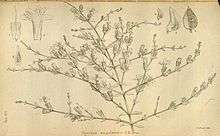William Philip Hiern

William Philip Hiern (19 January 1839 – 28 November 1925) was a British mathematician and botanist.[1]
Life
Hiern attended St. John's College, Cambridge, from 1857 to 1861 and attained a "first class degree" in mathematics . Later, in 1886, he attended Oxford University.
Upon his marriage he moved to Surrey and developed an interest in botany.
In 1881, Hiern moved to Barnstaple in north Devonshire, and lived at the manor house adjacent to the Barnstaple Castle mound. Hiern was quite taken with the country squire role and he assumed many public duties including those of the Lord of the Manor of Stoke Rivers, northeast of Barnstaple, and he was one of the original aldermen of the County of Devon.
Contributions
Hiern published over 50 works on botanical subjects. Among his chief works was the catalogue of Welwitsch’s African plants.[2]
Awards and honours
In 1903, Hiern was elected a fellow of the Royal Society.[4]
The African figwort genus Hiernia [5] was named in his honor, as was the Ixora hiernii (a tropical evergreen shrub), the Pavetta hierniana (an evergreen shrub) and the Coffea canephora var hiernii (a species of coffee plant).
Notes
- ↑ "HIERN, William Philip". Who's Who. Vol. 59. 1907. p. 838.
- ↑ Hiern, William Philip (1896) Catalogue of the African plants collected by Dr. Friedrich Welwitsch in 1853-61 (Volume 1) Trustees of the British Museum (Natural History), London. Published in several volumes 1896-1901.
- ↑ IPNI. Hiern.
- ↑ "Hiern, William Philip (HN857WP)". A Cambridge Alumni Database. University of Cambridge.
- ↑ "Hiernia" Plant Systemantics, a DOL (DiversityofLife.org) website
External links
- "William Philip Hiern (1839–1925)" Royal Albert Memorial Museum and Art Gallery